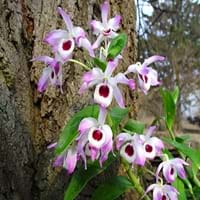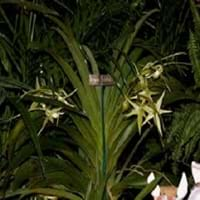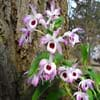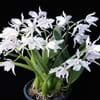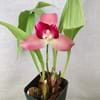Life Span
Perennial
Perennial
Origin
Eastern Asia, Southern Asia, Southeastern Asia, India, Nepal, China
Africa, Southern Africa, Madagascar
Types
Not available
Bethlehem Orchid, Christmas Orchid, Darwin's Orchid
Number of Varieties
Not Available
Habitat
Deciduous forests, Woodlands
Canopy, Forest edges
USDA Hardiness Zone
11-12
12-15
Habit
Clump-Forming
Clump-Forming
Flower Color
White, Purple, Pink, Burgundy, Dark Red, Ivory
White, Light Green
Flower Color Modifier
Multi-Color
Bicolor
Fruit Color
Non Fruiting Plant
Brown, Light Green
Leaf Color in Spring
Green
Green, Light Green
Leaf Color in Summer
Green
Light Green, Yellow green
Leaf Color in Fall
Green
Light Green, Yellow green
Leaf Color in Winter
Not Available
Light Green, Yellow green
Leaf Shape
Lance shaped
feather-shaped
Plant Season
Spring, Summer, Fall, Winter
Spring, Fall, Winter
Sunlight
Partial Sun, Partial shade
Partial Sun, Partial shade
Type of Soil
Not Available
Not Available
The pH of Soil
Acidic, Neutral
Not Available
Soil Drainage
Well drained
Well drained
Bloom Time
Early Spring, Spring, Late Winter, Indeterminate
Fall, Late Fall, Early Winter, Winter, Late Winter
Tolerances
Cold climate, Not Available
Not Available
Where to Plant?
Container, Ground, Pot
Container
How to Plant?
Cuttings, From bulbs, Rhizome division
Seedlings, stem tip cuttings
Plant Maintenance
Medium
Medium
Watering Requirements
Do Not over Water, Keep ground moist, Requires watering in the growing season
Water three times weekly in summer
In Summer
Lots of watering
Lots of watering
In Spring
Moderate
Moderate
In Winter
Average Water
Average Water
Soil pH
Acidic, Neutral
Not Available
Soil Type
Not Available
Not Available
Soil Drainage Capacity
Well drained
Well drained
Sun Exposure
Partial Sun, Partial shade
Partial Sun, Partial shade
Pruning
Cut leaves after fall, Prune in flowering season
Remove damaged leaves, Remove dead branches, Remove dead leaves
Fertilizers
Fertilize in early to mid-summer, Fertilzer with low nitrogen content
All-Purpose Liquid Fertilizer
Pests and Diseases
Red spider mite, Watery soft rot
Red blotch
Plant Tolerance
Cold climate
Drought
Flower Petal Number
Single
Single
Foliage Texture
Medium
Coarse
Foliage Sheen
Matte
Glossy
Attracts
Not Available
Not Available
Allergy
convulsions, Dermatitis, Toxic
Asthma
Aesthetic Uses
Beautification, Decorating walls, Hanging Basket, Used as an interior landscaping species, Used for decorating walls, fences, gates, hedges, etc.
Not Available
Beauty Benefits
Glowing Skin, Perfumes, Provides herbal hair care, Skin cleanser
Not Available
Environmental Uses
Food for animals, Food for birds
Air purification
Medicinal Uses
Analgesic, Antipyretic, Diabetes, Digestion problems, Eye Problems, Gallbladder Diseases, Liver Protection
Not Available
Part of Plant Used
Whole plant
Not Available
Other Uses
For making oil for cosmetics, Use in Chinese herbology, Used as Ornamental plant
Not Available
Used As Indoor Plant
Yes
Yes
Used As Outdoor Plant
Yes
Yes
Garden Design
Container, Hanging Basket, Houseplant, Rock Garden / Wall, Tropical
Container, Cutflower, Houseplant, Mixed Border, Tropical
Botanical Name
DENDROBIUM nobile
ANGRAECUM eburneum
Common Name
Dendrobium, Noble Dendrobium, Sentinel Orchid
Angraecum Orchid, Comet Orchid
In Hindi
Noble Dendrobium
Comet Orchid
In German
Noble Dendrobium
Angraecum sesquipedale
In French
Dendrobium nobile
Angraecum sesquipedale
In Spanish
Dendrobium nobile
Angraecum sesquipedale
In Greek
Dendrobium nobile
Comet Orchid
In Portuguese
Nobile Dendrobium
Angraecum sesquipedale
In Polish
Dendrobium szlachetne
Comet Orchid
In Latin
Nobile Dendrobium
Comet Orchid
Phylum
Tracheophyta
Vascular plant
Class
Equisetopsida
Liliopsida
Order
Asparagales
Asparagales
Family
Orchidaceae
Orchidaceae
Genus
Dendrobium
Angraecum
Clade
Angiosperms, Monocots
Angiosperms, Monocots
Tribe
Dendrobieae
Vandeae
Subfamily
Epidendroideae
Epidendroideae
Number of Species
Not Available
Season and Care of Nobile Dendrobium and Comet Orchid
Season and care of Nobile Dendrobium and Comet Orchid is important to know. While considering everything about Nobile Dendrobium and Comet Orchid Care, growing season is an essential factor. Nobile Dendrobium season is Spring, Summer, Fall and Winter and Comet Orchid season is Spring, Summer, Fall and Winter. The type of soil for Nobile Dendrobium is Not Available and for Comet Orchid is Not Available while the PH of soil for Nobile Dendrobium is Acidic, Neutral and for Comet Orchid is Not Available.
Nobile Dendrobium and Comet Orchid Physical Information
Nobile Dendrobium and Comet Orchid physical information is very important for comparison. Nobile Dendrobium height is 25.40 cm and width 15.20 cm whereas Comet Orchid height is 60.00 cm and width 50.80 cm. The color specification of Nobile Dendrobium and Comet Orchid are as follows:
Nobile Dendrobium flower color: White, Purple, Pink, Burgundy, Dark Red and Ivory
Nobile Dendrobium leaf color: Green
Comet Orchid flower color: White and Light Green
- Comet Orchid leaf color: Green and Light Green
Care of Nobile Dendrobium and Comet Orchid
Care of Nobile Dendrobium and Comet Orchid include pruning, fertilizers, watering etc. Nobile Dendrobium pruning is done Cut leaves after fall and Prune in flowering season and Comet Orchid pruning is done Remove damaged leaves, Remove dead branches and Remove dead leaves. In summer Nobile Dendrobium needs Lots of watering and in winter, it needs Average Water. Whereas, in summer Comet Orchid needs Lots of watering and in winter, it needs Average Water.
